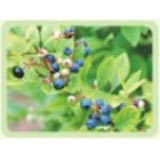Blueberry Extract -Anthocyanosides Anthocyanidin
111Category: Pharmaceuticals and Biochemicals

CAS NO: EC NO: Molecular Formula: Molecular Weight: Specification: Product description:
Latin Name(Semen Trigonellae) Active Ingredient(Anthocyanidin ) Specification(25%) Test Method(UV-VIS) There are three major blueberry types: Highbush (V. corymbosum L.) Lowbush blueberry (V. angustifolium Ation) Bilberries (European blueberry, V. myrtillus) Lowbush blueberries are wild and are made up of many different clones that exhibit a great deal of phytochemical diversity (Kalt et al. 1996). The lowbush fruit is smaller than that of the highbush variety (Kalt et al. 1996). The functional components of Vaccinium products appear to be the phenolic compounds, particularly the anthocyanins (Mazza and Oomah, 2000). Extracts of the bilberry, V. myrtillus, a type of European wild blueberry are widely used in prescription and over-the-counter medications (Kalt et al. 1994). There are currently over 180 Vaccinium pharmaceutical products available world wide. This type of medication has become increasingly popular, however the European crops cannot meet the global demand (Chein and Camire, 1996). France, Italy, Germany, and Korea have been particularly active in the development of bilberry products. The anthocyanins of bilberries and North American wild blueberries are generally similar (Kult and Dufour, 1997). Pharmaceutical manufactures are now considering lowbush blueberry extracts as an alternative to the expensive V. myrtillus extracts (Chein and Camire 1996). Composition Water is the primary constituent of wild blueberries (85%), followed by CHO (12%). Blueberries are also relatively high in fibre (3.0%), and magnesium (5mg/100g). Magnesium is required for the synthesis of antioxidant enzymes such as superoxide dismutase (Prior et al.1998; Mazza and Oomah; Kalt and Dufour, 1997; USDA Nutrient Database1998). Blueberries have great value in the food industry, they not only contribute flavour and colour, but they also enhance the nutritional profile of foods and can act as a partial or complete fat replacer. Reduced fat products benefit from the improved mouth-feel and texture that blueberries impart (NABC 1998).
if you are sourcing Blueberry Extract -Anthocyanosides Anthocyanidin from China ,just feel free to inquire



